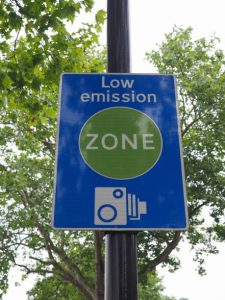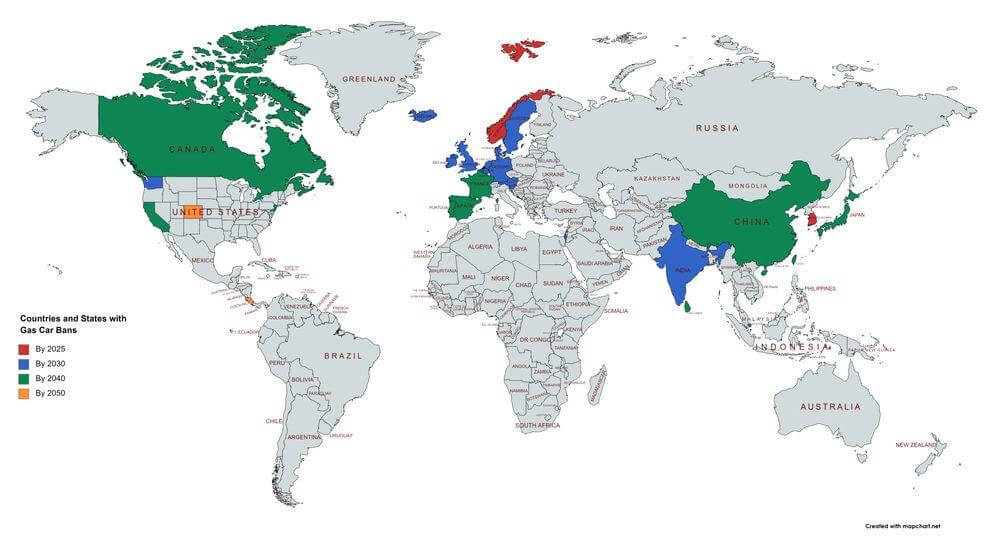Mandating Less Tailpipe Pollution

ICE Phase-Outs
Across the world today, city centers, municipalities, and even entire states and countries are proposing, mandating, and implementing internal combustion engine (ICE) vehicle phase-outs - in new vehicle sales, and on roads.
 The push to have electric vehicles (EVs) become the main vehicles on roads worldwide is driving the global ICE vehicle phase-out.
The push to have electric vehicles (EVs) become the main vehicles on roads worldwide is driving the global ICE vehicle phase-out.
These ICE phase-outs are primarily bans on the sales of new fossil fuel-powered vehicles, although some city centers are shutting down certain select city roads to ICE vehicles completely.

London was the first major metropolitan city worldwide to seriously restrict and regulate polluting ICE vehicle emissions. London curbed the use of inefficient vehicles that have high emissions on its city's roads with the use of a congestion charge (implemented in 2003), and a low emission zone (LEZ). London's initial LEZ was launched in 2008 (starting in 2019, London has implemented an ultra-low emissions zone, or ULEZ).
Paris followed London in 2017 by regulating tailpipe emissions with Crit'Air, and eventually began banning older models of petrol and diesel vehicles from certain roads. Crit'Air has now spread throughout France.
LEZs, such as those in London and Paris, are roads where ICE vehicles are still allowed for the most part, but tailpipe emissions are highly regulated. European emission standards for vehicles are strictly enforced in LEZs.
Similar momentum for ICE phase-outs in favor of EV-only and/ or cycling and pedestrian roads can be found in Copenhagen, Madrid, and Mexico City (to name just a few of many global cities).
Some European city centers are even going a step further, eliminating ICE vehicles on their streets altogether, creating zero-emission zones (ZEZ). City centers proposing and implementing complete ICE bans on certain roads include Oslo, London, Amsterdam, and Copenhagen (among others).
A new trend throughout European cities is banning older, more polluting ICE vehicles from city roads, or completely eliminating ICE vehicles from certain city roads, in ZEZ. Roads in ZEZ are meant for pedestrians, bicycles, electric micro-mobility, and, in some cases, zero-emissions vehicles and zero-emissions public transit. These zero-emission zones have regulations that don't allow for ICE vehicles at all.
In some cities, roads in a ZEZ are transformed into pedestrian and cycling zones, and vehicles are simply no longer permitted. In other cities, electric transit is part of a ZEZ - EVs, electric and hydrogen buses, electric trams, and other electric light rail are still allowed. (ZEZ technically allow for EVs and hydrogen fuel cell vehicles, unless all vehicles are specifically forbidden).
Copenhagen has pedestrian and cycling-only zones that have existed for decades. London's Square Mile also has a ZEZ. Additionally, the entire countries of Denmark and the United Kingdom (as well as a handful of other European countries) are planning on banning the sale of ICE cars by 2030. Norway has an even more ambitious goal - banning new ICE car sales by 2025.
In an ambitious move toward EVs and away from ICE vehicles, California will also start banning new ICE vehicle sales by 2035 (per a September 2020 decision by the state). California's move toward EVs in September 2020 includes an ambitious goal (100% EVs-only for new car sales by 2035), and is legally binding, as the measure has been passed by the state legislature and signed by the governor (the federal US goal for EV sales is only an executive ambition - 50% of new vehicle sales for the entire US to be electric by 2030).
California's target for EV-only sales by 2035 for new cars, versus much of the rest of the United States, is more in line with the ambitious timeline of those European countries and cities that are pioneering the global ICE ban movement.
EV-only/ pedestrian-only/ cycling-only/ zero-emission zones are popping up in:
- - Amsterdam (cycling, pedestrian, and/ or zero-emission mass transit zones on certain roads already in place, announced citywide ICE ban in 2019, older diesel cars target year - 2020, ICE buses - 2022, all ICE vehicles - 2030)
- - London (cycling, pedestrian, and/ or zero-emission mass transit zones on certain roads already in place, announced citywide ICE ban in 2017, target year - 2030)
- - Copenhagen (cycling, pedestrian, and/ or zero-emission mass transit zones on certain roads already in place, announced citywide ICE ban in 2017, target year - 2030). Copenhagen also plans to have all-electric buses in its city fleet by 2025.
- - Oslo (cycling, pedestrian, and/ or zero-emission mass transit zones on certain roads already in place, announced citywide ICE ban in 2019, city center target year - 2024, entire city target year - 2030)
- - Paris (cycling, pedestrian, and/ or zero-emission mass transit zones on certain roads already in place, ban of diesel vehicles announced in 2016, to take effect in 2025)
- - Brussels (cycling, pedestrian, and/ or zero-emission mass transit zones on certain roads)
- - MORE...
Vancouver plans to ban new ICE sales and have all-electric buses by 2025.
London plans to have 2,000 electric buses in its fleet by 2025. Many other European cities have similar plans to dramatically increase the share of all-electric buses (as many European cities now have diesel, diesel-electric hybrids, or other hybrid bus fleets).
Paris plans to put an ICE ban in place by 2025 on older, more polluting diesel and petrol vehicles (built prior to 2010 & 2006 respectively).
Reykjavik is shutting down half of its gas stations (by 2025). Oslo expects to have a ban on ICE cars on their city center streets, in addition to the ban on the sales of new ICE vehicles.
"The EU wants to phase out gas car sales by 2035, and many other countries have announced similar plans.
A gasoline vehicle phaseout is sometimes called an ICE ban - or an internal combustion engine ban. Many countries are planning for a diesel ban in addition to a gasoline ban for new car sales. The long list of countries planning to ban fossil fuel vehicles shows a growing trend of countries moving beyond gasoline to cleaner, cheaper alternatives."
[quote from - coltura.org/world-gasoline-phaseouts]
The EU hopes to make its ban on new ICE sales effective by 2035. President Biden signed an executive order (in August 2021) that half of all new vehicle sales are to be all-electric vehicles, or plug-in EV hybrids by 2030, through a series of ambitious goals and mandates set by his administration.
Spearheading the global ICE ban were countries like Norway (2017), Denmark (2018), and the Netherlands (2017), which proposed banning new ICE car sales starting in 2030, well before many other localities.
In 2017, the Norwegian Parliament developed an ambitious goal that all new vehicles should be zero-emission vehicles. Many European cities have developed similarly ambitious EV targets, as mentioned above, spurring ambitious targets from their own, and neighboring, countries.
Global ICE Vehicle Ban Movement
In fact, ICE vehicles are either being banned in new sales, or less efficient, higher emitting ICE vehicles are being regulated/ restricted from many European countries' roads.
California and other locations worldwide are joining in on the global ICE vehicle ban movement- see below list and map, generated as the EU-wide ICE ban was still just an idea. Here's a brief list of several pending ICE car bans in countries throughout the world [from - coltura.org]:
- UK: plans to ban sales of purely gasoline or diesel vehicles by 2030 Scotland: plans to phase out sales of new gasoline vehicles by 2032
- Denmark: plans to ban gasoline vehicles by 2030, and hybrids by 2035; has called on the European Union to expressly permit member states to enact 2030 bans
- Canada: plans to end the sale of new gas-powered cars and trucks by 2035, following plans by the province of Quebec to do the same.
- France: plans to ban sales of gasoline vehicles by 2040
- Germany: Bundesrat (upper house of legislature) passed resolution to only approve emission-free cars for use on the roads by 2030
- Iceland: plans to ban registration of new fossil fuel vehicles starting 2030; Reykjavik is eliminating half its gas stations by 2025
- Netherlands: all new cars must be emissions-free by 2030; Amsterdam is banning all gasoline/diesel vehicles from its streets by 2030
- Norway: plans to ban sales of gasoline vehicles by 2025 (currently 60% of new car sales are electric)
[list from - coltura.org/world-gasoline-phaseouts]

Here's a more extensive list of pending ICE vehicle bans throughout the world:
| Country or State | Year | Detail |
|---|---|---|
| Norway | 2025 | New vehicles |
| South Korea | 2025 | New vehicles |
| Belgium | 2026 | New company vehicles |
| Austria | 2027 | New taxis or car shares |
| Washington | 2027 | Government fleet |
| Slovenia | 2030 | New vehicles |
| Iceland | 2030 | New vehicles |
| Netherlands | 2030 | New vehicles |
| Denmark | 2030 | New vehicles |
| Ireland | 2030 | New vehicles |
| Israel | 2030 | New vehicles |
| Sweden | 2030 | New vehicles |
| India | 2030 | New vehicles |
| Germany | 2030 | New vehicles |
| United Kingdom | 2030 | New vehicles |
| Scotland | 2032 | New vehicles |
| Japan | 2035 | New vehicles |
| California | 2035 | New vehicles |
| China | 2040 | New vehicles |
| Singapore | 2040 | New vehicles |
| Sir Lanka | 2040 | New vehicles |
| Taiwan | 2040 | Bus (2030), motorcycle (2035), cars (2040) |
| Canada | 2040 | New vehicles |
| France | 2040 | New vehicles |
| Spain | 2040 | New vehicles |
| Portugal | 2040 | New vehicles |
| Egypt | 2040 | New vehicles |
| New Jersey | 2040 | New vehicles |
| District of Columbia | 2045 | Government and private fleet |
| Costa Rica | 2050 | New vehicles |
| Colorado | 2050 | New vehicles |
[List from - chargedfuture.com/countries-and-states-with-gas-car-bans]
"If humans have any hope of heading off the worst consequences of global heating, government action will be essential...there are [over] 31 national and local governments that have announced bans on the sale of some forms of transportation powered by internal combustion engines." [Quote from - chargedfuture.com/countries-and-states-with-gas-car-bans]